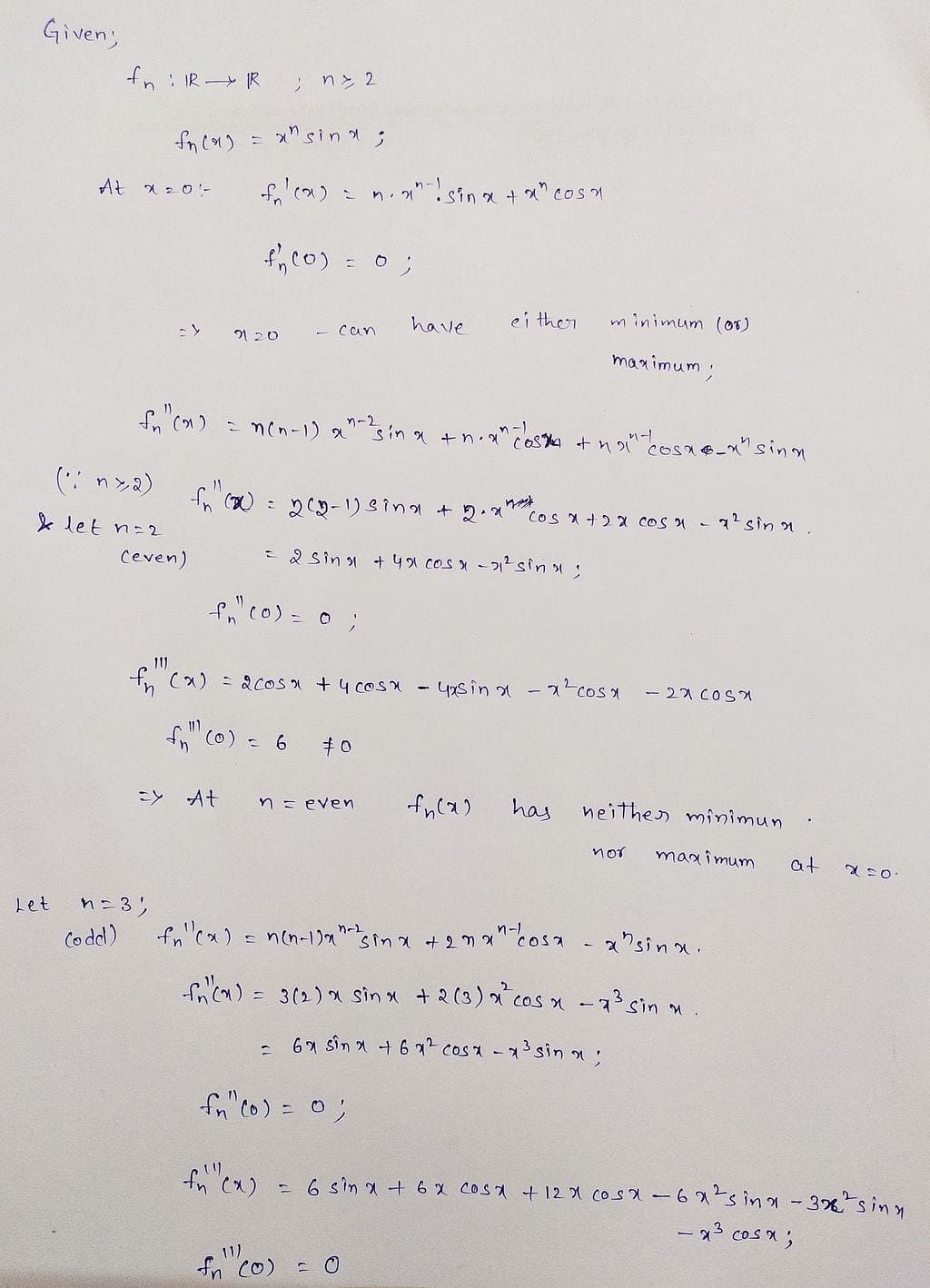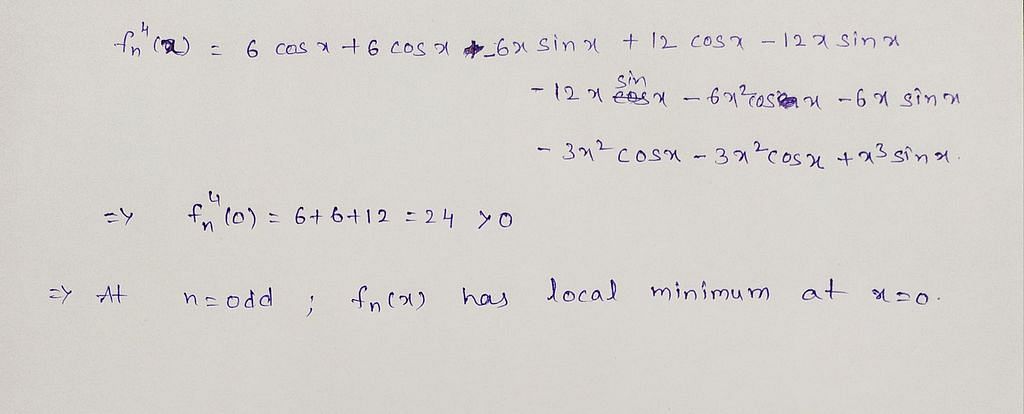NEET Exam > NEET Questions > For n≥ 2, let fn: R → R be given ...
Start Learning for Free
For n ≥ 2, let fn: R → R be given by fn(x) = xn sin x. Then at x = 0, fn has a
- a)local maximum if n is even
- b)local maximum if n is odd
- c)local minimum if n is even
- d)local minimum if n is odd
Correct answer is option 'D'. Can you explain this answer?
| FREE This question is part of | Download PDF Attempt this Test |
Most Upvoted Answer
For n≥ 2, let fn: R → R be given by fn(x) = xn sin x. Then...
Explanation:
To determine whether the function f_n(x) = x^n sin(x) has a local maximum or minimum at x = 0, we need to examine the behavior of the function near x = 0.
First Derivative Test:
Using the first derivative test, we can determine whether f_n(x) has a local maximum or minimum at x = 0 by examining the sign of f'_n(x) near x = 0.
f'_n(x) = n x^(n-1) sin(x) + x^n cos(x)
Odd and Even:
Now, we need to consider whether n is even or odd.
If n is even, then n-1 is odd, and x^(n-1) is positive near x = 0.
If n is odd, then n-1 is even, and x^(n-1) is negative near x = 0.
Positive and Negative:
Next, we need to consider the sign of sin(x) and cos(x) near x = 0.
sin(x) is positive for x > 0 and negative for x < 0.="" />
cos(x) is positive for x > 0 and negative for x < 0.="" />
Conclusion:
Therefore, if n is even, then f'_n(x) is positive for x > 0 and negative for x < 0="" near="" x="0." this="" means="" that="" f_n(x)="" has="" a="" local="" minimum="" at="" x="0." />
If n is odd, then f'_n(x) is negative for x > 0 and positive for x < 0="" near="" x="0." this="" means="" that="" f_n(x)="" has="" a="" local="" maximum="" at="" x="0." />
So, in this case, the correct answer is option (D) local minimum if n is odd.
To determine whether the function f_n(x) = x^n sin(x) has a local maximum or minimum at x = 0, we need to examine the behavior of the function near x = 0.
First Derivative Test:
Using the first derivative test, we can determine whether f_n(x) has a local maximum or minimum at x = 0 by examining the sign of f'_n(x) near x = 0.
f'_n(x) = n x^(n-1) sin(x) + x^n cos(x)
Odd and Even:
Now, we need to consider whether n is even or odd.
If n is even, then n-1 is odd, and x^(n-1) is positive near x = 0.
If n is odd, then n-1 is even, and x^(n-1) is negative near x = 0.
Positive and Negative:
Next, we need to consider the sign of sin(x) and cos(x) near x = 0.
sin(x) is positive for x > 0 and negative for x < 0.="" />
cos(x) is positive for x > 0 and negative for x < 0.="" />
Conclusion:
Therefore, if n is even, then f'_n(x) is positive for x > 0 and negative for x < 0="" near="" x="0." this="" means="" that="" f_n(x)="" has="" a="" local="" minimum="" at="" x="0." />
If n is odd, then f'_n(x) is negative for x > 0 and positive for x < 0="" near="" x="0." this="" means="" that="" f_n(x)="" has="" a="" local="" maximum="" at="" x="0." />
So, in this case, the correct answer is option (D) local minimum if n is odd.
Free Test
FREE
| Start Free Test |
Community Answer
For n≥ 2, let fn: R → R be given by fn(x) = xn sin x. Then...


Attention NEET Students!
To make sure you are not studying endlessly, EduRev has designed NEET study material, with Structured Courses, Videos, & Test Series. Plus get personalized analysis, doubt solving and improvement plans to achieve a great score in NEET.

|
Explore Courses for NEET exam
|

|
Similar NEET Doubts
For n≥ 2, let fn: R → R be given by fn(x) = xn sin x. Then at x = 0, fn has aa)local maximum if n is evenb)local maximum if n is oddc)local minimum if n is evend)local minimum if n is oddCorrect answer is option 'D'. Can you explain this answer?
Question Description
For n≥ 2, let fn: R → R be given by fn(x) = xn sin x. Then at x = 0, fn has aa)local maximum if n is evenb)local maximum if n is oddc)local minimum if n is evend)local minimum if n is oddCorrect answer is option 'D'. Can you explain this answer? for NEET 2024 is part of NEET preparation. The Question and answers have been prepared according to the NEET exam syllabus. Information about For n≥ 2, let fn: R → R be given by fn(x) = xn sin x. Then at x = 0, fn has aa)local maximum if n is evenb)local maximum if n is oddc)local minimum if n is evend)local minimum if n is oddCorrect answer is option 'D'. Can you explain this answer? covers all topics & solutions for NEET 2024 Exam. Find important definitions, questions, meanings, examples, exercises and tests below for For n≥ 2, let fn: R → R be given by fn(x) = xn sin x. Then at x = 0, fn has aa)local maximum if n is evenb)local maximum if n is oddc)local minimum if n is evend)local minimum if n is oddCorrect answer is option 'D'. Can you explain this answer?.
For n≥ 2, let fn: R → R be given by fn(x) = xn sin x. Then at x = 0, fn has aa)local maximum if n is evenb)local maximum if n is oddc)local minimum if n is evend)local minimum if n is oddCorrect answer is option 'D'. Can you explain this answer? for NEET 2024 is part of NEET preparation. The Question and answers have been prepared according to the NEET exam syllabus. Information about For n≥ 2, let fn: R → R be given by fn(x) = xn sin x. Then at x = 0, fn has aa)local maximum if n is evenb)local maximum if n is oddc)local minimum if n is evend)local minimum if n is oddCorrect answer is option 'D'. Can you explain this answer? covers all topics & solutions for NEET 2024 Exam. Find important definitions, questions, meanings, examples, exercises and tests below for For n≥ 2, let fn: R → R be given by fn(x) = xn sin x. Then at x = 0, fn has aa)local maximum if n is evenb)local maximum if n is oddc)local minimum if n is evend)local minimum if n is oddCorrect answer is option 'D'. Can you explain this answer?.
Solutions for For n≥ 2, let fn: R → R be given by fn(x) = xn sin x. Then at x = 0, fn has aa)local maximum if n is evenb)local maximum if n is oddc)local minimum if n is evend)local minimum if n is oddCorrect answer is option 'D'. Can you explain this answer? in English & in Hindi are available as part of our courses for NEET.
Download more important topics, notes, lectures and mock test series for NEET Exam by signing up for free.
Here you can find the meaning of For n≥ 2, let fn: R → R be given by fn(x) = xn sin x. Then at x = 0, fn has aa)local maximum if n is evenb)local maximum if n is oddc)local minimum if n is evend)local minimum if n is oddCorrect answer is option 'D'. Can you explain this answer? defined & explained in the simplest way possible. Besides giving the explanation of
For n≥ 2, let fn: R → R be given by fn(x) = xn sin x. Then at x = 0, fn has aa)local maximum if n is evenb)local maximum if n is oddc)local minimum if n is evend)local minimum if n is oddCorrect answer is option 'D'. Can you explain this answer?, a detailed solution for For n≥ 2, let fn: R → R be given by fn(x) = xn sin x. Then at x = 0, fn has aa)local maximum if n is evenb)local maximum if n is oddc)local minimum if n is evend)local minimum if n is oddCorrect answer is option 'D'. Can you explain this answer? has been provided alongside types of For n≥ 2, let fn: R → R be given by fn(x) = xn sin x. Then at x = 0, fn has aa)local maximum if n is evenb)local maximum if n is oddc)local minimum if n is evend)local minimum if n is oddCorrect answer is option 'D'. Can you explain this answer? theory, EduRev gives you an
ample number of questions to practice For n≥ 2, let fn: R → R be given by fn(x) = xn sin x. Then at x = 0, fn has aa)local maximum if n is evenb)local maximum if n is oddc)local minimum if n is evend)local minimum if n is oddCorrect answer is option 'D'. Can you explain this answer? tests, examples and also practice NEET tests.

|
Explore Courses for NEET exam
|

|
Suggested Free Tests
Signup for Free!
Signup to see your scores go up within 7 days! Learn & Practice with 1000+ FREE Notes, Videos & Tests.
























